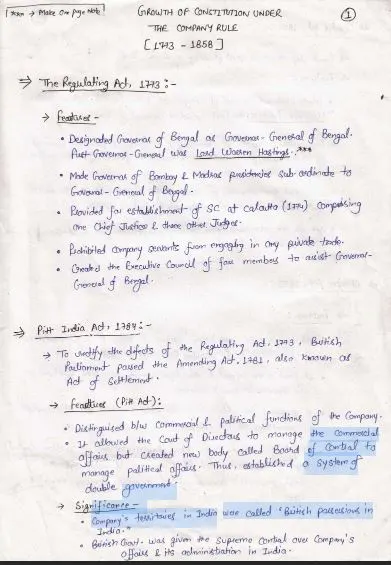‘Laxmikant Polity Handwritten Notes’ PDF Quick download link is given at the bottom of this article. You can see the PDF demo, size of the PDF, page numbers, and direct download Free PDF of ‘Polity Handwritten Notes’ using the download button.
Laxmikant Polity Handwritten Notes PDF Free Download

Laxmikanth Indian Polity Handwritten Notes PDF
What is the Regulating Act of 1773?
The regulating Act of 1773 was passed by the British Parliament to control the territories of the East India Company majorly in Bengal.
This act was passed due to the misgovernment by the British East India government that introduced a situation of bankruptcy and the government had to interfere with the affairs of the Company.
Background
Remember one thing this law was not for Indians, this law was passed by the British Parliament to control (regulate) the East India Company.
After the battle of Buxar the Company became the de facto ruler of the provinces of Bengal, Bihar, and Orissa. And get Diwani right over the huge province. Direct income from Diwani makes officials more greedy.
The reins of administration in the provinces were on the Company’s servants, who were paid very little. They took full advantage of this opportunity and started exploiting the Indians
There was only one aim of them, how they can take maximum money to England by looting in India.
Due to high wages and the wealth they had accumulated through exploitation, After becoming rich Company officials returned home(Britain), fueling another controversy in British society.
Merchants of Britain were unable to trade with the East because of the Company’s monopoly, Many British ministers and other members of Parliament also wanted to benefit from the wealth of Bengal.
To gain public support, they forced the Company to pay taxes to the British government.
In 1767, Parliament passed an Act mandating the Company to pay four million pounds a year to the British government.
British politics had become extremely corrupt in the late 18th century. The Company and its officials obtained membership in the House of Workers through the power of money.
Many British politicians were concerned that the plunder of India would put the Company and its officials in a position to exert decisive influence over the British government.
Thus there was a need for reorganization of the British State and Company officials.
The situation was that while the employees of the company were consolidating more and more money, the business of the company was running into losses; when the company had to seek a loan of one million pounds from the government.
The company paid a lot of money to the government in order to maintain the monopoly, but since 1768 the company was unable to meet its commitments because
of the loss of tea sales in America1. By 1773 the company was in horrible financial straits.
There was a dispute in the British Parliament that the officers of the company were getting rich and the company was suffering losses.
But if the Company had many powerful enemies, it also had powerful friends in Parliament. In addition, Emperor George III was his patron.
That’s why the company fiercely faced its enemies. In the end, Parliament issued an Accord Out There, according to which a permanent balance was maintained between the opening of the Company and the various glittering words of British society.
It was decided that the British government would continue to control the majorities of the Company’s Indian administration so that British rule in India could be carried out in the collective interest of Britain’s higher minorities.
At the same time, the Company’s monopoly of trade with the East will remain and its valuable right to appoint your officers in India will also remain in its hands.
Importance Of Regulating Act
This act is of great constitutional importance as
(a) it was the first step taken by the British Government to control and regulate the affairs of the East India Company in India;
(b) it recognized, for the first time, the political and administrative functions of the Company; and
(c) it laid the foundations of central administration in India.
Features of the Regulating Act 1773(Key Provision)
The Act limited the Board of Directors mandates to four years and the limited partnership’s earnings to six percent until it paid back a debt of £1.5 million.
- It designated the Governor of Bengal as the ‘Governor-General of Bengal‘.
- The first such Governor-General was Lord Warren Hastings.
- It laid the foundation for India’s centralized administration.
- Creation of Executive Council to Assist the Governor-General: an Executive Council of four members to assist him.
- Simple majority voting will be used to make decisions, with the Governor General casting the lone vote in a tie.
- It made the governors of Bombay and Madras to presidencies subordinate to the governor-general of Bengal, unlike earlier when the three presidencies were independent of one another.
- Establishment of the Supreme Court at Judicature at Fort William: In the year 1774, the Supreme Court of Judicature at Fort William was established at Calcutta.
- One Chief Justice and three other judges.
- The first Chief Judge of the newly constituted Calcutta Supreme Court is Sir Elijah Impey
- while Lemester, Chambers, and Hyde were the other judges of the court
- The court is endowed with both civil and judicial authority.
- There is also original and appellate jurisdiction available.
- The jurisdiction of this court extended to all areas lying under the Bombay, Madras, and Bengal Presidency.
- Reforms to curb corruption: This act brought prohibition the servants of the company from engaging in any private trade or accepting bribes and gifts from the local people.
- The directors of the company were to be elected for a period of five years and one-fourth of them used to retire every year.
- There was no procedure for re-election available.
- Term & Members: This law established that the board of directors’ term would be 4 years and the number of members would be increased to 24, with 6 members having a one-year leave of absence.
- Court of Directors: The Crown’s authority was further enhanced by the “Court of Directors” via this act.
- It strengthened the control of the British all hot Government over the Company by requiring 100 the Court of Directors (governing body of the Company) to report on its revenue, civil, and military affairs in India.
- Pay Rise: The company’s officers and staff were given a pay raise.
The Contribution of the Act:
- Changes in the structure of the judiciary: This enactment is considered to be a landmark enactment as it brought a lot of dynamic and significant changes in the structure of judiciary in the country.
- Court of Directors (COD): The act brought changes some important changes in the Constitution of the Court of Directors (COD)
- For the first time, the political and administrative functions of the company were recognized.
- This act also laid down the foundation of the Central Administration in the country.
- This act created for the first time Supreme Court at Calcutta thereby, making a proper judicial system and Judiciary got regulated to an extent for the first time learned judges from England were made part of the Supreme Court in India.
Defects of Regulating Act 1773
The major drawbacks of The Regulating Act of 1773 are stated below:
- The act rendered the Governor-General without any veto power. He was overruled most of the time by the majority decision of the members of his council. He was responsible for all his acts to the court of directors and answerable for the administrative decisions taken in India.
- It did not address the concerns of the Indian population who were paying revenue to the company.
- Debilitation of administration: The governors of Bombay and Madras presidencies were subordinate and ultimate powers were laid in the governor’s hands. It led to the debilitation of administration at subordinate levels and the persistence of corruption. It did not stop corruption among the company officials.
- Lack of division of powers: The provisions regarding the powers and jurisdictional issue of the supreme court at fort Williams were vague and defective.
It did not specify the division of powers of the governor-general and the supreme court. Company officials’ conduct was under the supreme court’s purview, resulting in tensions between the governor-general and the apex court. - The Supreme Court’s powers were not well-defined.
- The parliamentary control that was sought in the activities of the company proved to be ineffective as there was no mechanism to study the reports sent by the Governor-General in Council.
- The parliament was ineffective in scrutinizing the reports sent by the governor-general.
After the failure of the act, An Amendment Act was passed in 1781 in order to fix the problems with the Regulating Act of 1773. It provided evidence of the connection between the Supreme Court and the Governor General. The “Declaratory Act of 1771” was another name for it.
| Language | English |
| No. of Pages | 136 |
| PDF Size | 1 MB |
| Category | Education |
| Source/Credits | Drive.com |
Laxmikant Polity Handwritten Notes PDF Free Download
